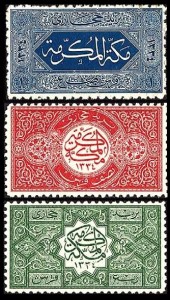“Quite close to the north bank of the Masturah, we found the well … As we watched, two riders, trotting light and fast on thoroughbred camels, drew towards us from the north. Both were young. One was dressed in rich Cashmere robes and heavy silk embroidered head-cloth. The other was plainer, in white cotton, with a red cotton head-dress. They halted beside the well; and the more splendid one slipped gracefully to the ground without kneeling his camel, and threw his halter to his companion, saying, carelessly, ‘Water them while I go over there and rest’. Then he strolled across and sat down under our wall, after glancing at us with
affected unconcern. He offered a cigarette, just rolled and licked, saying, ‘Your presence is from Syria?’ I parried politely, suggesting that he was from Mecca, to which he likewise made no direct reply. We spoke a little of the war and of the leanness of the Masruh she-camels.
“Meanwhile the other rider stood by, vacantly holding the halters, waiting perhaps for the Harb to finish watering their herd before taking his turn. The young lord cried, ‘What is it, Mustafa? Water them at once’. The
servant came up to say dismally, ‘They will not let me’. ‘God’s mercy!’ shouted his master furiously, as he scrambled to his feet and hit the
unfortunate Mustafa three or four sharp blows about the head and
shoulders with his riding-stick. ‘Go and ask them.’ Mustafa looked hurt, astonished, and angry as though he would hit back, but thought better of it, and ran to the well.
The Harb, shocked, in pity made a place for him, and let his two camels drink from their water-trough. They whispered, ‘Who is he?’ and Mustapha said, ‘Our Lord’s cousin from Mecca’. At once they ran and untied a bundle from one of their saddles, and spread from it before the two riding camels fodder of the green leaves and buds of the thorn trees. They were used to gather this by striking the low bushes with a heavy staff, till the broken tips of the branches rained down on a cloth stretched over the ground beneath.
The young Sherif watched them contentedly. When his camel had fed, he climbed slowly and without apparent effort up its neck into the saddle, where he settled himself leisurely, and took an unctuous farewell of us, asking God to requite the Arabs bountifully. They wished him a good journey; and he started southward, while Abdul
